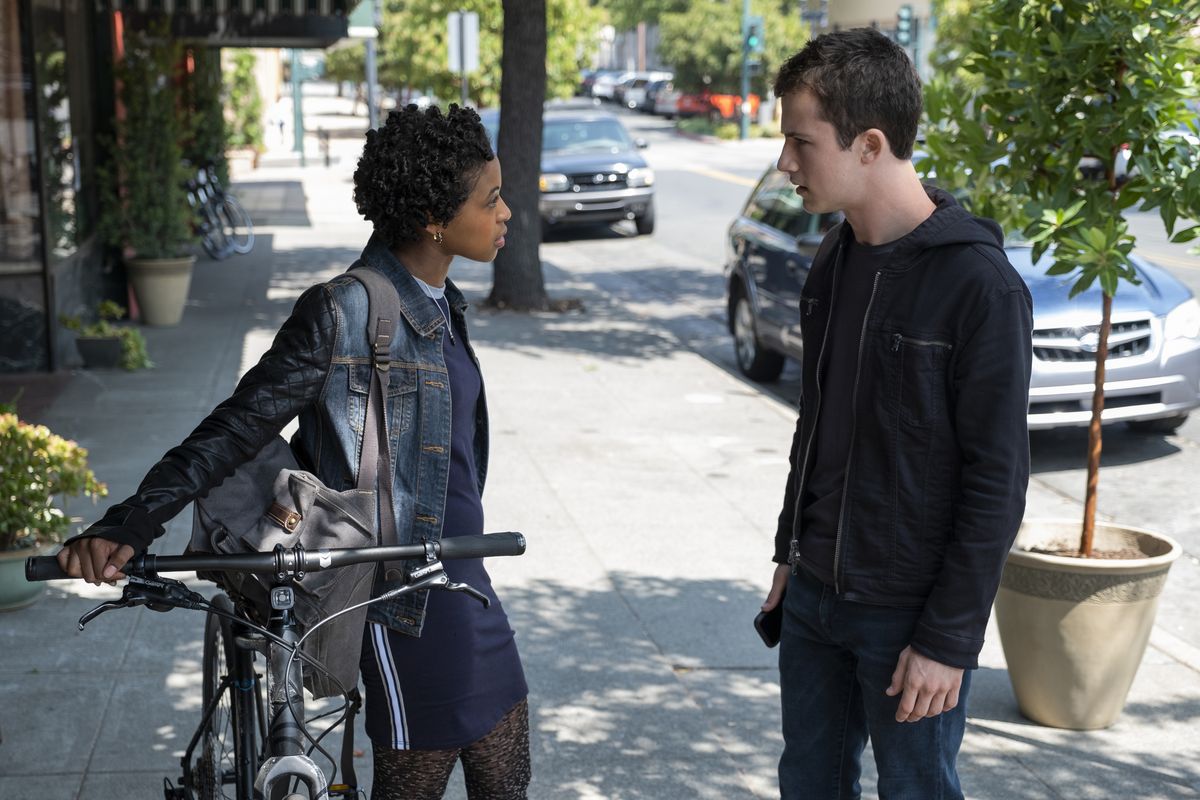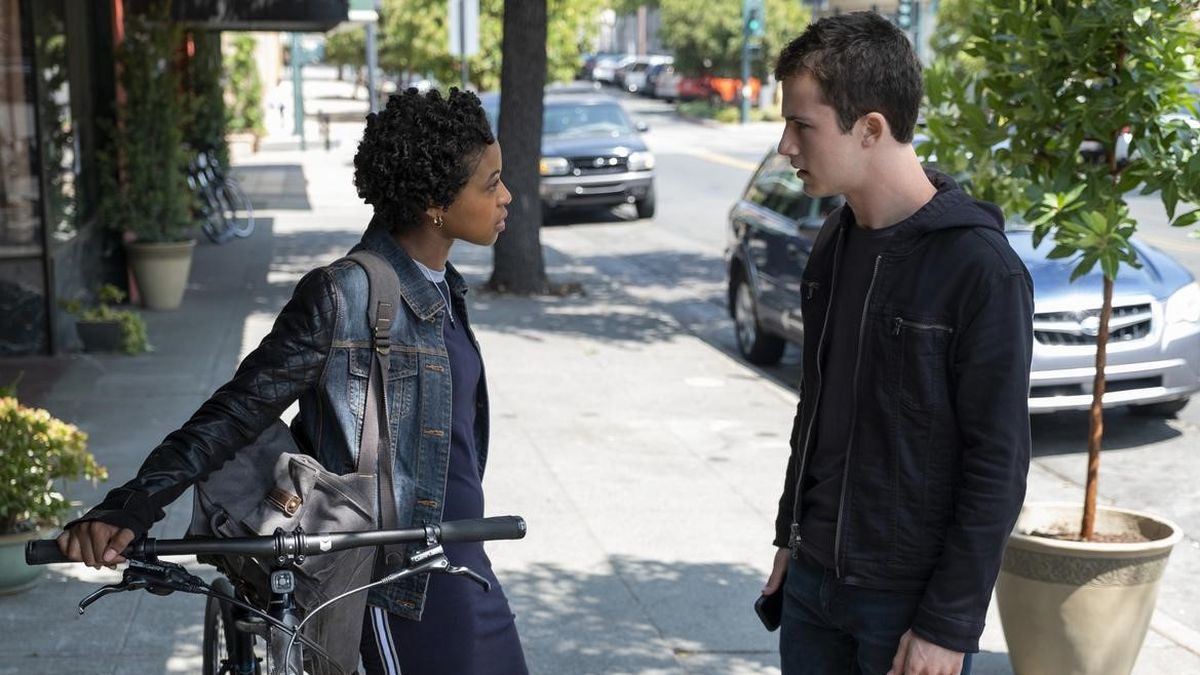Shows are working to connect viewers with help – thank ‘13 Reasons Why’
Grace Saif as Ani Achola and Dylan Minette as Clay Jensen star in “13 Reasons Why.” The show is a big reason there’s been an increased effort to make sure viewers know about mental health and other resources when shows feature traumatic storylines. (David Moir)
When Netflix debuted “13 Reasons Why” in the spring of 2017, it quickly became one of the platform’s most popular – and controversial – offerings. The drama, which counted Selena Gomez among its executive producers and was adapted from the bestselling YA novel by Jay Asher, was full of issues teens navigate in high school: dating, consent, LGBTQ identity, drug use and more. And like its source material, the show revolved around the death by suicide of its protagonist, Hannah Baker.
Almost immediately following its largely acclaimed debut season, “13 Reasons Why” (which took its fourth and final bow on Netflix last month) was steeped in debate over the show’s approach to its central story line and other sensitive topics, including sexual assault. Experts decried a graphic scene depicting Hannah’s manner of death and, amid concerns that the show glamorized teen suicide, educators and mental health advocates raised alarms about the risk for suicide contagion or copycat scenarios.
TV shows for teens have long grappled with serious topics, but “13 Reasons Why” presented challenges that are uncommon to the streaming era. What if – in the interest of a show attempting to address important social issues – every episode is a very special episode? And what is the responsibility of TV creators who produce on-demand content that could affect vulnerable viewers? In confronting those questions, the biggest legacy of “13 Reasons Why” might be helping to map out an industry blueprint for dealing with such sensitive topics.
For decades, advocacy organizations have worked with TV producers and writers to ensure safe messaging around difficult subjects. But the conversations generated by “13 Reasons Why” marked “something of a tipping point,” said Christine Moutier, chief medical officer for the American Foundation for Suicide Prevention.
“We certainly had been approached, on occasion, prior to that. But since then, I couldn’t even count the number of writers’ rooms and content creators we’ve worked with,” Moutier said. “The progression has been tremendous.”
The need for collaboration between advocates and TV creators is increasingly relevant. A study published last year in the Journal of the American Academy of Child and Adolescent Psychiatry associated “13 Reasons Why” with a rise in suicides among U.S. children ages 10 to 17 in the month after the show’s Season 1 premiere on March 31, 2017. According to the study, funded in part by the National Institutes of Health and its National Institute of Mental Health, the show was linked to a 28.9% increase in suicide rates in that age group. Researchers cited more suicides in April 2017 than in any other month over the five-year range analyzed by the study.
A study published days earlier from the University of Pennsylvania’s Annenberg Public Policy Center said watching the series in its entirety could actually be beneficial for viewers but still indicated that its “findings confirm concerns about the show’s potential for adverse effects on vulnerable” ones. (According to data from the Centers for Disease Control and Prevention, suicide was the second-leading cause of death for adolescents and young adults ages 15 to 24 in 2017.)
The authors of both studies urged Netflix and other content creators to provide additional resources for young viewers.
Though “13 Reasons Why” launched with episodic content warnings, a companion site linking to mental health resources and an after-show titled “Beyond the Reasons” (which featured commentary from mental health experts), in response to the Season 1 backlash, Netflix added more content warnings, expanded its resource list and echoed advice from experts who urged parents and their teens to view and discuss the series together. The streaming giant also sought advice from the AFSP and other experts. When the second season premiered in May 2018, the first episode was prefaced with a PSA featuring the show’s main cast. A similar video plays before the third season.
Such PSAs are helpful, experts say, when it comes to making sure young people can separate fiction from reality. In the “13 Reasons Why” PSA, the show’s cast members introduce themselves, setting a clear distinction between an actor and the character they play. According to a Northwestern University study commissioned by Netflix, two-thirds of the parents surveyed in the study expressed interest in PSAs that featured the cast “coming out of character.”
Dan Reidenberg, executive director of Suicide Awareness Voices of Education, consulted on “13 Reasons Why” before and after the Season 1 controversy. Reidenberg created a tool kit for watching the series with resources tailored to young viewers, parents, educators, doctors and journalists.
“If you look at some of the research that came out about Season 1 – increases in hospitalizations, increases in people searching online for how to die by suicide, an unusual number of suicides compared to years before in the same time period,” Reidenberg said, “that suggests that all people in the entertainment industry, not just Netflix, need to really pay attention to some of the science.”
As with suicide, experts say, depictions of sexual violence can be harmful if they don’t fall in line with what experts recommend – an issue that also plagued “13 Reasons Why,” which was criticized for its handling of sexual assault across multiple seasons. Scott Berkowitz, founder and president of the Rape, Abuse and Incest National Network, said the nonprofit organization has worked with more TV creators in the past decade than in previous years.
“The industry has really grown to see the big impact it has on people and the importance of these kinds of partnerships and working with folks who bring some subject matter expertise,” Berkowitz said. “And I think that as sexual violence has become a much bigger part of the national conversation, story lines around this issue are coming up much more frequently than they used to.”
RAINN’s national sexual assault hotline is featured prominently on the resources page for Michaela Coel’s HBO series “I May Destroy You,” which centers on a sexual assault. The organization said it has an ongoing relationship with HBO and that the network reached out to RAINN about including the hotline, which connects sexual assault survivors to local providers trained to help. Last year, the organization reported a 40% increase in calls to the hotline after the number was featured in Part 2 of Lifetime’s documentary “Surviving R. Kelly.”
Netflix also developed a partnership with AFSP after its work on “13 Reasons Why,” Moutier, the chief medical officer, said. The organization consulted on “All the Bright Places,” the platform’s film adaptation of Jennifer Nevin’s YA bestseller, which features teen characters struggling with mental illness and suicidal thoughts.
But the biggest development to result from AFSP’s work with Netflix arrived ahead of “13 Reasons Why’s” third season – when the streaming company announced it had removed the controversial scene depicting Hannah’s death.
In a statement, Netflix said it had “been mindful about the ongoing debate around the show” and made the decision to pull the scene on the recommendation of Moutier and other experts. “We believe this edit will help the show do the most good for the most people while mitigating any risk for especially vulnerable viewers,” said “13 Reasons Why” creator Bryan Yorkey, who had previously defended its inclusion.
The final season of “13 Reasons Why” focuses heavily on a major character’s treatment for mental illness, which entails therapy – a plot development SAVE’s Reidenberg said marked somewhat of a “full circle” moment for the show.
“Their entire goal from Day 1 – before Year 1 – was to start a conversation, ” he said. “And they did that.”

